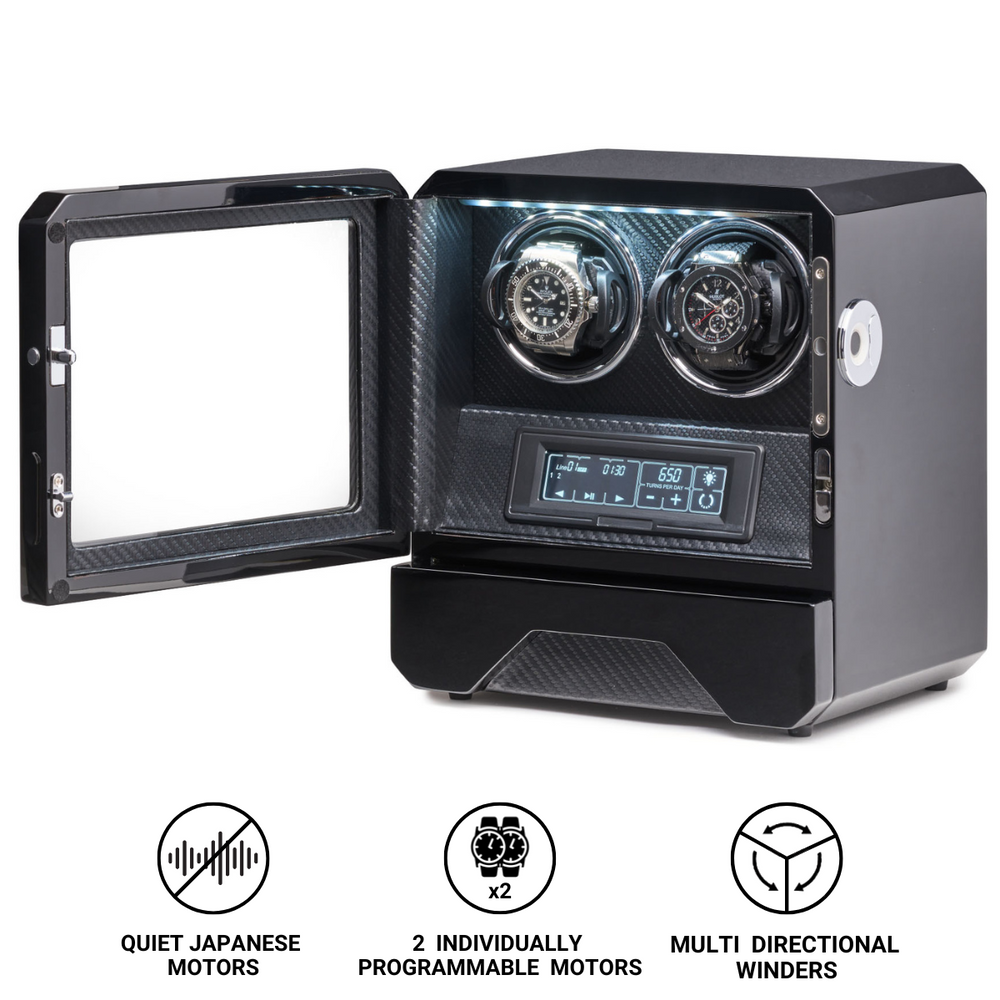What is Gilt Dial?
Few features in vintage watch design evoke as much admiration and nostalgia as the gilt dial. Characterised by gold-toned lettering, numerals, and markers set against a dark background, the gilt dial represents one of the most distinctive and celebrated styles in the history of horology. Beyond its aesthetic beauty, it symbolises an era of meticulous craftsmanship, when watchmaking was as much an art form as it was a technical pursuit.
The term “gilt” refers to the process of applying a thin layer of gold to another surface. In the context of watches, however, it is not about literal gold plating but rather a unique method of dial printing that results in luminous golden text and details shining through a glossy black lacquer. The effect is subtle yet striking, exuding warmth and depth that modern printing methods often fail to replicate.
The Origins of the Gilt Dial
The gilt dial first appeared during the 1930s and gained popularity through the 1940s, 1950s, and 1960s, a period widely considered the golden age of mechanical watchmaking. At that time, dials were not mass-produced by automated machinery but crafted through labour-intensive techniques involving multiple layers of lacquer, etching, and chemical treatments.
Manufacturers developed the gilt printing process to create visually rich dials that contrasted beautifully with the metallic cases of the era. The deep black or dark brown lacquer, combined with the reflective golden markings, gave these watches a distinctive glow under light. It was both practical and luxurious, ensuring legibility while enhancing visual appeal.
The process was quickly adopted by some of the most prestigious brands, including Rolex, Omega, Longines, and Jaeger-LeCoultre. Rolex, in particular, played a major role in popularising the gilt dial through its early Submariner, Explorer, and GMT-Master models. These watches became icons, not only for their functionality but also for their mesmerising aesthetic balance between form and purpose.
How Gilt Dials Were Made
Creating a gilt dial was a delicate and complex process requiring precision and patience. The method relied on reverse printing, in which the golden elements were not applied on top of the surface but revealed from beneath it.
-
Base Material and Preparation
The process began with a brass dial plate, which served as the foundation. This surface was treated to expose the metal and prepare it for the next stage. -
Printing the Negative Layer
The text, markers, and logos were printed in a clear or resist varnish on the raw metal surface. This varnish protected the underlying brass from later coatings, effectively reserving those areas that would eventually appear gold. -
Application of Lacquer
A rich layer of black or dark lacquer was then applied over the entire surface of the dial. Once this hardened, the areas covered by the resist varnish were gently removed or polished, revealing the golden brass beneath. -
Finishing and Protection
Finally, the dial was polished and sealed with a layer of transparent lacquer to protect it and give it the deep, glossy appearance characteristic of true gilt dials.
This meticulous process created a unique optical depth. The golden elements were not raised or printed but appeared as if they were floating beneath the surface of the lacquer, shimmering when caught by light.
The complexity of production meant that each gilt dial had subtle variations, making every piece slightly different. Over time, exposure to sunlight and humidity would age the lacquer, often resulting in beautiful brownish tones known as tropical patina.
The Distinctive Look of Gilt Dials
A true gilt dial is immediately recognisable by its rich, glossy surface and warm, golden details. The contrast between the dark lacquer and the gold elements gives the watch an unmistakable sense of depth and vintage charm.
Unlike modern dials printed with metallic inks, gilt dials possess a luminous, almost liquid quality. The reflective gold lettering interacts with light in a dynamic way, shifting in intensity depending on angle and brightness. This subtle play of light contributes to their enduring appeal among collectors.
Common features of gilt dials include:
-
Gold or champagne-coloured text, logos, and chapter rings.
-
High-gloss or mirror-like black lacquer.
-
Warm, slightly aged tones due to oxidation or UV exposure.
-
Raised or sunken indices that complement the overall golden theme.
This combination of technical precision and natural ageing gives gilt dials an unmatched depth of character. No two examples age identically, making each dial a unique expression of time’s passage.
Iconic Watches with Gilt Dials
Some of the most celebrated vintage watches feature gilt dials, and their desirability among collectors continues to grow. A few notable examples include:
-
Rolex Submariner 5512 and 5513
Produced in the late 1950s and early 1960s, these models are among the most famous gilt-dial watches ever made. Their glossy black dials with gold text became emblematic of early professional tool watches. -
Rolex Explorer 1016
The gilt versions of the Explorer 1016, with their signature 3-6-9 dial layout, epitomise understated elegance. Their warm, glowing markings give them a timeless charm that modern recreations rarely match. -
Omega Seamaster and Constellation
Some mid-century Omega models featured gilt lettering combined with dark dials and polished indices, blending sportiness and sophistication. -
Longines Chronographs
Longines produced gilt chronograph dials during the 1940s and 1950s, notable for their exquisite printing and balance of functionality with artistry.
Each of these watches demonstrates how the gilt dial transformed an ordinary tool or dress watch into an object of enduring beauty.
The Decline of Gilt Dials
By the late 1960s, the gilt printing process had largely disappeared. Advances in manufacturing introduced more efficient and cost-effective techniques, such as pad printing and silk-screening. These allowed for faster production but lacked the depth and richness of traditional gilt dials.
Moreover, the rise of matte and brushed finishes in watch design shifted aesthetic preferences away from the glossy, reflective look that defined the gilt era. As a result, true gilt dials became relics of a bygone age, treasured by collectors for their craftsmanship and rarity.
In the decades that followed, many gilt dials also developed natural patina due to environmental exposure. Some darkened to a rich chocolate brown, while others exhibited spider-web cracking or fading, further enhancing their individuality. These imperfections became badges of authenticity, making surviving examples even more desirable.
The Revival of the Gilt Dial
In recent years, as appreciation for vintage design has grown, several manufacturers have reintroduced the gilt aesthetic in their modern collections. While contemporary gilt-style dials are typically created using printed metallic inks rather than traditional reverse-lacquering, they aim to capture the spirit of the originals.
Brands such as Tudor, Omega, and Longines have produced models with gilt-inspired details, often paired with domed crystals and warm luminous material to evoke the vintage look. The Tudor Black Bay collection, for instance, is one of the most prominent modern interpretations, featuring gold-tone text and hands against black or brown dials.
These modern versions offer improved durability and legibility while paying homage to one of the most beloved dial styles in horological history. Yet for purists, nothing can replace the authentic warmth and depth of a true mid-century gilt dial, created through the original labour-intensive process.
The Collector’s Perspective
For collectors, gilt dials represent the pinnacle of vintage watch artistry. Their rarity, craftsmanship, and aesthetic appeal make them some of the most sought-after dials in the world.
Several factors influence the value of a gilt dial watch:
-
Condition: A well-preserved glossy surface with intact golden details is highly prized. Cracks, over-polishing, or moisture damage can reduce value.
-
Authenticity: Many dials have been refinished over time, so verifying original gilt printing is essential. The genuine process cannot be replicated exactly.
-
Patina: Aged gilt dials with even, warm patina are especially admired. Collectors often prefer honest ageing to artificial restoration.
-
Model and Rarity: Watches like early Rolex Submariners or Explorers with gilt dials command significant premiums due to their historical significance.
Owning a gilt dial watch is often less about perfection and more about character. Each dial tells a visual story of its journey through time, light, and care.
The Emotional and Artistic Appeal
The gilt dial holds a unique place at the intersection of technology and art. Its creation required not just precision engineering but also an artistic sensibility capable of balancing light, colour, and depth.
When viewed closely, a gilt dial feels alive. The golden details shimmer softly under changing light, creating a dialogue between the dial and its environment. This interaction gives the watch a sense of movement even when it is at rest.
The appeal of the gilt dial extends beyond nostalgia. It symbolises a time when craftsmanship and individuality defined watchmaking, long before mass production and modern standardisation. For many enthusiasts, it captures the soul of mechanical horology — a world where beauty, precision, and human touch were inseparable.
Conclusion
The gilt dial remains one of the most celebrated achievements in the history of watch design. Born from meticulous craftsmanship and artistic ingenuity, it embodies the elegance and sophistication of mid-century horology.
While modern manufacturing has moved toward efficiency and uniformity, the allure of the gilt dial endures. Its warm tones, rich gloss, and historical depth continue to fascinate collectors and watch lovers alike.
In a world obsessed with perfection, the gilt dial reminds us of the beauty found in craftsmanship, time, and subtle imperfection. It is a testament to an era when even the smallest detail — the glow of gold beneath lacquer — could capture the imagination and elevate a simple watch into a timeless work of art.









